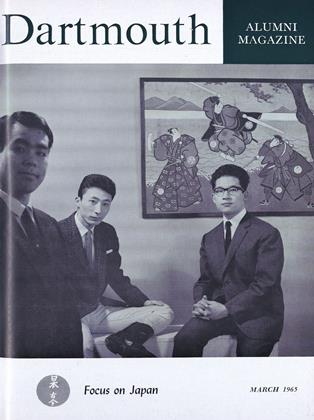A TEAM of 12 students in Engineering Science 21, an introductory Thayer School course, has won a design prize for producing a machine that simultaneously types contracted Braille and printed words, without requiring the user to know Braille.
The engineering class, divided into five "companies," had the assignment last term to develop devices that would help in the rehabilitation of blind and crippled children at the Crotched Mountain Rehabilitation Center in Greenfield, N. H. The competition was sponsored by Design News magazine, which presented a plaque and a check to the winning company, "Dartmouth Devices Amalgamated." The students donated their award money to the Crotched Mountain Rehabilitation Center.
The winning typewriter-Brailler is constructed so that the typist need not know Braille, only the 189 English words contracted in the commonly used form known as Grade 2 Braille. Thus the machine serves as a valuable means of communication, either way, between the blind and persons who have sight.
Devices designed by the other groups in the class included a Braille typewriter which produces printed words and Grade 1 Braille; two paraplegic communication devices; a triceps arm crutch, and a prosthetic device for augmenting the arm.
Judging the designs were: Dr. Cairbre McCann, medical director of the Crotched Mountain Rehabilitation Center; Dr. Joseph D. Thompson, consultant to the creative engineering course at the General Electric Co. in Schenectady, N. Y.; Dean John Hodgins of the Department of Engineering, McMaster University, Hamilton, Ont.; Dr. A. Bernice Clark, regional representative of the U. S. Department of Health, Education and Welfare; and Dr. Donald Pierce, assistant in orthopedic surgery at Massachusetts General Hospital.
This is the third year that Dartmouth engineering students have been given an introduction to engineering through a realistic case-study approach, according to Prof. Paul T. Shannon, director of the introductory course. He explained that this course differs from many others because it teaches the students design principles, rather than analysis. The faculty members teach the students elementary considerations of engineering organization and design.
The typewriter-Brailler designed by the winning group is not yet in a marketable stage, but they did produce a working prototype. They also found in their market survey that there was a considerable demand for such a device provided the cost could be reduced. The students estimated the production cost of their final design would be $625, labor included.
 View Full Issue
View Full Issue
More From This Issue
-
 Feature
FeatureTHE EDUCATION LADDER
March 1965 By PROF. BURTON E. MARTIN '33 -
 Feature
FeatureFocus on
March 1965 -
 Feature
FeatureAlumni in Japan
March 1965 -
 Feature
FeatureHonorable President in Japan
March 1965 -
 Class Notes
Class Notes1930
March 1965 By WALLACE BLAKEY, HARRISON F. CONDON JR. -
 Class Notes
Class Notes1920
March 1965 By GEORGE H. MACOMBER, ALBERT W. FREY
Article
-
 Article
ArticleSeniors Elect Officers
April, 1911 -
 Article
ArticleCONTRIBUTIONS ANALYZED BY COUNCIL DISTRICTS
November 1918 -
 Article
ArticleAlumni Articles
July 1958 -
 Article
ArticleWarner Bentley To Direct Center
May 1960 -
 Article
ArticleTradition Quiz Answers
FEBRUARY 1990 -
 Article
ArticleStudent Scientists Organize
June 1948 By Aaron R.Rausen '51.

